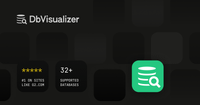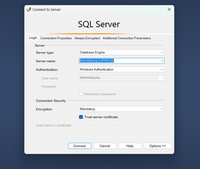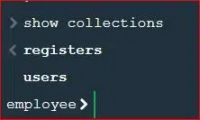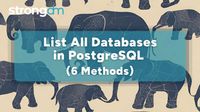Explore web search results related to this domain and discover relevant information.

DbVisualizer offers features for database developers, analysts, and DBAs. It lets you easily build, maintain, optimize, and analyze a large variety of databases.
DbVisualizer has everything you need to build, manage and maintain state-of-the-art database technologies.DbVisualizer lets you visualize, manage and edit data with the power of SQL and simplicity of a spreadsheet.Control the execution of scripts from outside the DbVisualizer UI.DbVisualizer is set up to meet the toughest security standards.

The SHOW DATABASES command is a universal SQL query that retrieves and lists all databases in the current DBMS accessible to the user. This eliminates the need to directly query system tables and simplifies database management tasks. SQL specification of the `SHOW DATABASES` command is not ...
The SHOW DATABASES command is a universal SQL query that retrieves and lists all databases in the current DBMS accessible to the user. This eliminates the need to directly query system tables and simplifies database management tasks. SQL specification of the `SHOW DATABASES` command is not complex and is simple enough to be used on different SQL universally.Your All-in-One Learning Portal: GeeksforGeeks is a comprehensive educational platform that empowers learners across domains-spanning computer science and programming, school education, upskilling, commerce, software tools, competitive exams, and more.In the dynamic scene of database management, having a good insight into the available databases for effective administration and development tasks. SHOW DATABASES command is designed to present all databases located on the server.This article explores the purpose, syntax, and practical applications of the SHOW DATABASES command, along with examples to demonstrate its use in various SQL implementations like MySQL, PostgreSQL, and SQLite.

In summary, the SHOW DATABASES command in MySQL turns out to be a powerful tool either for the DBAs or for developers.
Your All-in-One Learning Portal: GeeksforGeeks is a comprehensive educational platform that empowers learners across domains-spanning computer science and programming, school education, upskilling, commerce, software tools, competitive exams, and more.Likewise, it may incorporate 5 tables to wit: user, db, tables_priv, columns_priv, and host all hold the information about users, databases, and their permissions.The MySQL, SHOW DATABASES is used to list the databases that are within the MySQL environment. It prints all the databases including the default system databases. It depends on the user whether they want to print all the databases or some specific databases. We can use 'LIKE', and 'WHERE' clauses to specify the databases that we want to print.Explanation: In the above example we are printing all the schemas whose name starts with s. There are a total of 3 schemas whose name starts with 's' including one system schema. Here we cannot use the WHERE clause directly with SHOW DATABASE so we are using information_schema.SCHEMATA table to use the WHERE clause.
The SHOW DATABASES command is a universal SQL query that retrieves and lists all databases in the current DBMS accessible to the user. This eliminates the need to directly query system tables and simplifies database management tasks. SQL specification of the `SHOW DATABASES` command is not ...
The SHOW DATABASES command is a universal SQL query that retrieves and lists all databases in the current DBMS accessible to the user. This eliminates the need to directly query system tables and simplifies database management tasks. SQL specification of the `SHOW DATABASES` command is not complex and is simple enough to be used on different SQL universally.Your All-in-One Learning Portal: GeeksforGeeks is a comprehensive educational platform that empowers learners across domains-spanning computer science and programming, school education, upskilling, commerce, software tools, competitive exams, and more.In the dynamic scene of database management, having a good insight into the available databases for effective administration and development tasks. SHOW DATABASES command is designed to present all databases located on the server.This article explores the purpose, syntax, and practical applications of the SHOW DATABASES command, along with examples to demonstrate its use in various SQL implementations like MySQL, PostgreSQL, and SQLite.


In this tutorial, you will learn how to show databases in a PostgreSQL server using psql and pg_database catalog.
Summary: in this tutorial, you will learn how to show databases in a PostgreSQL database server.In MySQL, you can show all databases in the server using SHOW DATABASES statement.PostgreSQL does not directly support the SHOW DATABASES statement but offers you something similar.PostgreSQL provides you with two ways to show databases in a PostgreSQL database server.
If there are no connections, the SHOW CONNECTIONS command returns "No connections available".
If there are no connections, the SHOW CONNECTIONS command returns "No connections available".SHOW INDEXES displays all the indexes in the database.SHOW PROCEDURES displays all the procedures in the database that have been created with the CREATE PROCEDURE statement, as well as system procedures.SHOW SCHEMAS displays all of the schemas in the current connection.
For example, developers will use it to explore the current environment, and DBAs will need it to carry out routine server maintenance. ... In this article, you will get a comprehensive guide on how to show databases in MySQL and filter them according to certain criteria.
Maintenance is yet another vital operation, which requires DBAs to identify old, unused, or temporary databases, and clean them up to free up space and improve performance. A quick way to see all databases will definitely be useful here. Run the following query to show all databases in MySQL:You can run this statement from the MySQL Command Line Client, MySQL Shell, or any GUI tool that supports SQL (for example, dbForge Studio for MySQL). MySQL returns the results in a table with one column - Database. The databases are ordered in alphabetical order. The number of rows in the set is the number of databases. Note Unless you have the global SHOW DATABASES privilege, you will see only the databases you are permitted to see.For example, the following statement returns the same result as the SHOW DATABASES command. SELECT schema_name FROM information_schema.schemata; And again, the query can be run from the MySQL Command Line Client, MySQL Shell, or dbForge Studio for MySQL.Also note that in dbForge Studio, database tables can be displayed by expanding nodes in Database Explorer. There are several reasons why the SHOW DATABASES command might not display all databases on your server.

I can access all of my databases with HeidiSQL, but if I go to the mysql.exe window and use show databases; only 2 of them show up out of 11. These are all databases on 127.0.0.1. Any ideas on why?
You're logging into HeidiSQL as root, so it's showing you all databases, but you're logging into mysql.exe as the current Windows user (since that's the default), so it's only showing you the databases that that user can see.First, you have to log in using your username and password before you issue show databases command on cmd. If you request show databases without this, cmd will only show you default databases. your username and password(optional if you username is root) grant you the needed access to the databases.I'm logging in with the username root for HeidiSQL. When I'm using mysql, I'm just typing showdatabases;If you run mysql.exe with --user=root --password=..., it will show you all databases.


Your All-in-One Learning Portal: GeeksforGeeks is a comprehensive educational platform that empowers learners across domains-spanning computer science and programming, school education, upskilling, commerce, software tools, competitive exams, and more.
Listing all databases in SQL Server is a common task for database administrators and developers. SQL Server provides two main methods to solve this such as using SQL commands and using SQL Server Management Studio (SSMS). In this article, we will learn about how to Show/List the SQL Server Databases using both approaches in detail.We can use a command prompt in our system or SQL Server Management Studio (SSMS) to execute our SQL commands. Below are the commands or queries to show databases in the SQL Server system.

By using commands such as show dbs and db.stats() and users can gain valuable insights into their MongoDB environment.
By using commands like show dbs and db.stats(), users can get detailed information such as database size, collections and the number of documents.The most basic command for listing the databases in the MongoDB shell is 'show dbs'. This command prints the list of databases and their sizes.After executing `show dbs`, MongoDB prints out a list of the databases in our system with the sizes of each database in megabytes (MB).While show dbs gives a brief but useful outline, you can drill down into specific databases by using db.stats() function.

With MariaDB’s SHOW TABLES, you can generate an overview of all the tables in a database. We’ll show you how it works here.
MariaDB offers two methods for selecting a database within its management system. In this dedicated article, we illustrate how to use the USE statement in the command line and the mysql_select_db function in PHP with a straightforward example, and also highlight what you need to…You can use the parameter LIKE to filter the results from SHOW TABLES. This can be especially useful when working with large databases that contain lots of tables. Even though our example only contains three tables, we can still use it to see how LIKE works.If, in addition to the names of the tables, you also want to find out what types of tables you have in your database, you can use MariaDB’s SHOW TABLES together with FULL. This adds an additional column to the output named “table_type”. This column provides information about the table type using one of three categories: BASE TABLE, VIEW and SEQUENCE.If you need an overview of all the tables in a MariaDB database, you can use SHOW TABLES . Starting from version 11.2.0, this administrative statement also includes temporary tables.
The SHOW DATABASES statement lists all database in the CockroachDB cluster.
The SHOW DATABASES statement lists all databases in the CockroachDB cluster.

SHOW DATABASES lists the databases on the MariaDB server host.SHOW SCHEMAS is a synonym forSHOW DATABASES. The LIKE clause, if present on its own, indicates which database names to match.
CONNECT DBF Table Type · CONNECT DOS and FIX Table Types · CONNECT - External Table Types · CONNECT - Files Retrieved Using Rest Queries · CONNECT INI Table Type · CONNECT JDBC Table Type: Accessing Tables from Another DBMS · CONNECT JSON Table Type · CONNECT MONGO Table Type: Accessing Collections from MongoDB ·CONNECT ODBC Table Type: Accessing Tables From Another DBMS · CONNECT PIVOT Table Type · CONNECT PROXY Table Type · CONNECT Table Types - Catalog Tables · CONNECT Table Types - Data Files · CONNECT Table Types - OEM: Implemented in an External LIB · CONNECT Table Types - Special "Virtual" Tables ·The WHERE and LIKE clauses can be given to select rows using more general conditions, as discussed in Extended SHOW.You see only those databases for which you have some kind of privilege, unless you have the global SHOW DATABASES privilege.

MySQL provides a convenient way to list down all the databases using SHOW DATABASES command where as there is no particular command in MS SQL Server to show or list the databases but, you can use the SELECT...FROM command as a work around list down available databases.
MySQL provides a convenient way to list down all the databases using SHOW DATABASES command where as there is no particular command in MS SQL Server to show or list the databases but, you can use the SELECT...FROM command as a work around list down available databases.The SQL SHOW DATABASES statement is used to list down all the available databases in MySQL database.You can use SHOW SCHEMAS as an alternate command for SHOW DATABASES.We can use LIKE or WHERE clause along with SHOW DATABASES to filter out a list of databases.
To show a list of databases in SQL you can use these commands: ... Let's see them in more detail. Oracle has a different server-database model to SQL Server and MySQL, called Container Databases and Pluggable Databases. I've written a guide to them here. If you want to see the current name of the database: ... If you want to see a list of users or schemas on the server, you could query the dba...
To show a list of databases in SQL you can use these commands: ... Let's see them in more detail. Oracle has a different server-database model to SQL Server and MySQL, called Container Databases and Pluggable Databases. I've written a guide to them here. If you want to see the current name of the database: ... If you want to see a list of users or schemas on the server, you could query the dba_users view.This will show a list of database names. You can filter this using a WHERE clause if needed. Some sources say you can filter this based on dbid > 4 or dbid > 6 to exclude system databases.This should show you the names of databases.However, the preferred approach is selecting from the table, as you can filter the results and show more columns if needed.


Download the latest DbVisualizer version here, with installers for Windows, macOS, Linux or Unix.
You can download and use DbVisualizer for free. To unlock all features and to get full support you will need a Pro license.Please note DbVisualizer will not run on your mobile or tablet.You are currently viewing an old version of DbVisualizer.There is no recommended installer for unknown for this DbVisualizer version.
+-----------------------------...--+----------------+-------------------+-----------------|-------------------| | 2023-01-27 14:33:11.417 -0800 | BOOKS_DB | N | N | | DATA_ADMIN | | | 1 | STANDARD | ROLE | NULL | | 2023-09-15 15:22:51.111 -0700 | TEST_DB | N | N | | ACCOUNTADMIN ...
+-------------------------------+-----------------------------------------------------------+------------+------------+-----------------------------------------------------------+--------------+---------+---------+----------------+-------------------+-----------------+-------------------+ | created_on | name | is_default | is_current | origin | owner | comment | options | retention_time | kind | owner_role_type | OBJECT_VISIBILITY | |-------------------------------+-----------------------------------------------------------+------------+------------+--------------------------------------------For SHOW commands that support both the FROM 'name_string' and STARTS WITH 'name_string' clauses, you can combine both of these clauses in the same statement.This new column is appended to the existing views and is reserved for future use. For more information, see DATABASES and SCHEMATA views, and SHOW DATABASES and SHOW SCHEMAS commands: New column in output.Show all databases that you have privileges to view in your account:

On the DBeaver dashboard, navigate to the “Database Navigator” pane and select “New Database Connection.” ... In the new dialog window, select the “PostgreSQL” tab at the top of the dashboard. · Toggle the “Show all databases” setting. This step is tool-specific and may not ...
On the DBeaver dashboard, navigate to the “Database Navigator” pane and select “New Database Connection.” ... In the new dialog window, select the “PostgreSQL” tab at the top of the dashboard. · Toggle the “Show all databases” setting. This step is tool-specific and may not apply to all versions of DBeaver.Having a complete view of all your databases in PostgreSQL is essential for effective database management. This guide explores six proven methods you can use to quickly list all of your databases.If you want advanced features beyond just listing databases, you can leverage third-party tools like DBeaver and DataGrip. These tools provide features such as advanced data visualization, cross-platform compatibility, data analysis, and entity relationship (ER) diagrams.You understand how tools like psql, pgAdmin, and DBeaver work.

You can list your databases using the Cypher command SHOW DATABASES. ... All databases. A particular database. The DBMS default database.
The results have been filtered to only show database names containing 'o'. It is also possible to use SKIP and LIMIT to paginate the results. ... +--------------------------------------------+ | name | currentStatus | requestedStatus | +--------------------------------------------+ | "movies" | "online" | "online" | | "neo4j" | "online" | "online" | +--------------------------------------------+ To view the default Cypher version of each database in the DBMS, run the command SHOW DATABASES with the YIELD clause and specify the defaultLanguage column.how to list databases in Neo4j, use SHOW DATABASES command, see all available databases, databases states. How to filter listed databases in Neo4j.A summary of all available databases can be displayed using the command SHOW DATABASES.In this example, the detailed information for a particular database can be displayed using the command SHOW DATABASE name YIELD *. When a YIELD clause is provided, the full set of columns is returned.
SHOW DATABASES lists the databases on the MySQL server host. SHOW SCHEMAS is a synonym for SHOW DATABASES. The LIKE clause, if present, indicates which database names to match.
Because any static global privilege is considered a privilege for all databases, any static global privilege enables a user to see all database names with SHOW DATABASES or by examining the SCHEMATA table of INFORMATION_SCHEMA, except databases that have been restricted at the database level by partial revokes.MySQL 8.4 Reference Manual / ... / SQL Statements / Database Administration Statements / SHOW Statements / SHOW DATABASES StatementSHOW DATABASES lists the databases on the MySQL server host. SHOW SCHEMAS is a synonym for SHOW DATABASES. The LIKE clause, if present, indicates which database names to match.The WHERE clause can be given to select rows using more general conditions, as discussed in Section 28.8, “Extensions to SHOW Statements”.




